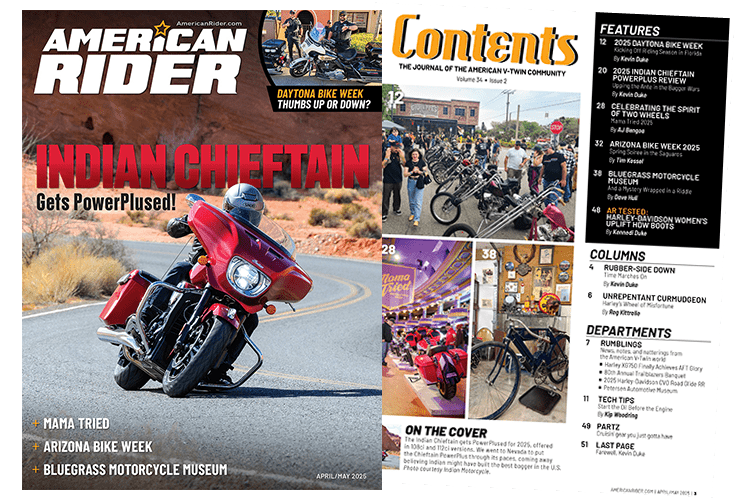
The street in front of my house is a county road, moderately busy during morning and evening rush hours and with a random trickle of traffic in between. It’s a connector of sorts between the Interstate and the two-lane U.S. highway that runs through my town, and because of that, motorcyclists take this road quite regularly. There are a lot of small riding groups and occasionally a local club run will go past my house.
But for the past few weeks, it’s been rather quiet around here. Winter has firmly planted its roots in the Northeast soil, and I haven’t seen or heard a motorcycle in several weeks. Nor have I gotten mine out very often. Oh, sure, there was the New Year’s Day ride, and a few 300-mile round-trip excursions to Southeast Pennsylvania to get some customization done on my new FLHR, and there may be a few more road trips before the weather breaks, but mostly, the bikes sit idle.
Spring, or Imbolc, as it’s known in certain cultures, is the time when the earth reawakens, when everything is born anew. But wintertime is when the real magic happens, when introspection occurs, seeds are sown and plans are lain. And although I’d rather be on the road, it’s a fine time to think about the upcoming riding season. So I sit in front of the computer in my office, staring out the window into the backyard which has just been covered with a fresh two-inch layer of snow.
Much as I look forward to hitting the road, there are some places where a bike just can’t take me. And others where I just don’t have the time due to deadlines or other commitments, or the snow and ice make the ride difficult, dangerous, and sometimes downright impossible. For instance, riding the 1,100-plus miles to Daytona Beach for Bike Week, which I’ve ridden several times, the latest with snow on the roads and me white-knuckling it nearly the entire way, even dropping the bike on ice during one frigid trip.
One alternative transportation choice involves the Amtrak Auto Train, where I ride only 240 miles from my home to Lorton, Virginia, and when I arrive in Sanford, Florida, some 17 hours later, refreshed and ready to roll, I’m only 40 miles to Daytona. The Auto Train is a relic of a bygone era, when travel by rail was celebrated with luxury trappings, from the cocktail hour to the meals served on fine china in the exclusive dining car to the movies shown after dinner. Watching the world whiz by while sitting in my private sleeper compartment puts me in a peaceful, contented, and sometimes meditative state unmatched by any other mode of transport—except actually riding my motorcycle, of course. And my bike enjoys the same pampering, traveling along with me in a specially-modified rail car. The Auto Train gives a whole new meaning to “riding by rail.”
Riding from where I live in the Northeast to any number of Southeastern destinations also brings in other transportation options that can accommodate my bike as well as me. Although it might be a little slower to hug the coast than to traverse the Interstate, I truly enjoy riding my bike onto the Cape May-Lewes Ferry that carries us from the southernmost tip of New Jersey across the Delaware Bay to the northern portion of the Delmarva Peninsula. The 80-minute crossing provides a pleasant lunch break on my way to, well, most any destination along the Atlantic coast. After arriving at the Lewes, Delaware, terminal, the relaxing 150-mile ride down mostly rural secondary roads then brings me to the Chesapeake Bay Bridge-Tunnel that traverses a spectacular 23-mile route over and under the waters where the Chesapeake Bay meets the Atlantic Ocean. When construction was completed in 1964, the magnificent structure was selected as one of the seven engineering wonders of the modern world, and it still leaves me in awe every time I ride it. Plus there’s a surprisingly good restaurant, the Chesapeake Grill, and gift shop on the man-made Sea Gull Island that offers sweeping views of Chesapeake Bay.
Many other water-crossing options are available where roads don’t exist to get my bike and me from one point to another. Another pleasurable crossing is the ferry from Hatteras Island on the southern tip of the Outer Banks to Ocracoke Island, where shortly after departing the ferry you can stop to see the wild horse before you reach the village rich with pirate lore. Other ferries in include those to Cedar Island and Swan Quarter. There are seven North Carolina ferry routes in all, and some are free.
I’ve made several trips to Milwaukee, Wisconsin, for Harley-Davidson anniversary celebrations, the Milwaukee Rally, and just to visit the Harley-Davidson Museum and other attractions. Had it not been for the ferries, I most likely wouldn’t have wanted to ride there. I’ll do just about anything to avoid the dreaded Chicago traffic that makes traveling I-90/I-94 corridor such a nightmare. There are two ferries I’ve taken across Lake Michigan: the S.S. Badger, an older, slower, less expensive option that’s a straight 80-mile shot south to Milwaukee, and the newer, quicker, pricier (but cushier) Lake Express Ferry that leaves you just a few miles from the museum.
While traveling in Canada, I’ve taken several ferries in Quebec, each offering marvelous opportunities to enjoy picturesque views from different perspectives not seen from land, all while my bike is traveling with me. Numerous vehicle-carrying ferries exist in North America, and I’m convinced it’s one of the best ways to tour those places that you can’t reach by motorcycle or even just need a better way to get there.


















